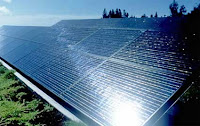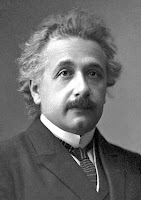 |
| Solar panels convert sun's energy into electricity |
We all know that solar panels are made of silicon but did you know that silicon is a semi conductor of electricity?! More else silicon is an insulator at some certain temperatures so the electric current can't pass through it so what is the trick!! To figure out this, we have to know about a natural phenomenon called the photoelectric phenomenon.
Photoelectric effect
 |
| Albert Einstein (
1879 –1955) |
This phenomenon wasn't explained except in the 20th century. It was explained by max plank and Albert Einstein, in brief light was not only a wave but light is from the electromagnetic series which consists of visible-light gamma rays x-rays and radio waves.
Each component of the electromagnetic series has affixed wavelength and a fixed frequency, thus a fixed energy when light falls on a surface it transmits the energy to the electrons. So an electron or more can escape the attraction of the nucleus, but this electron is not separated from the whole surface, but it is freed from the atom but still contained in the crystal so to sum up if the energy of the falling light is equal to the work function of the surface falling on it the electron is freed from the atom the above explanation was introduced by Einstein.
So what is the relation between all these scientific facts and lightning our houses?!
 |
| A section in a solar panel cell |
These are the principals on which any solar panel works no matter, what is its size or voltage or even its power?
The silicon atom has 14 electrons 2,8,4 is the electronic configuration for the so the outer most shell is half-filled with electrons so the atom shares it with four neighboring atoms it seems like holding hands with each other so their outer most shell is totally filled. So electrons can't loose easily so another process called doping takes place where impurities are introduced between silicon atoms, this process could be achieved by introducing one impurities atom for one million silicon atom we always think of impurities as useless (harmful) things but not in here our cell won't without these impurities, the doping is done by two ways doping by elements of the 5th group and doping by elements of the 3rd group when we use a 5th group element as phosphorus it has five electrons in its outer most shell so it shares four electrons with the neighboring atoms, and the one is attracted to the proton in the nucleus so with the little amount of energy this electron is freed, and we have n-type crystal where n stands for negative as there are excess negative electrons in the crystal. And by using the 3rd group elements as aluminum or gallium it contains three electrons in the outer most shell so it shares them with the neighboring atoms, and a hole is found in the bond due to the absence of the fourth electron so these holes are considered positive, and so they are called p-type so when those two pieces are put together there is a great rush from the electrons in the n region to the p region so right at the junction, there is kind of barrier, which doesn't allow all the electrons to go to the p region from the movement of electrons an electric between the two regions an electric current is produced, and the regions gain different electrical poles so the voltage is generated so we have current and voltage, so we have power, which is their product, we need power to use it in operate different appliances.
We have one problem is that silicon has a shiny surface so the photons would bounce off before doing their job so the silicon is coated with anti refractive substance, and a glass sheet is spread above it to protect its elements.





 Posted in:
Posted in: